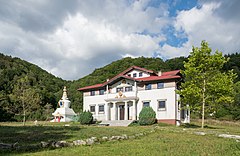Buddhism in Poland


The roots of
Today all of the principal schools of Buddhism including
History
The roots of
Professor of

The first Buddhist group in Poland was organized by Piotr Boniński from
Only at the turn of the 1960s and 1970s, a group of people associated with the studio of painters Urszula Broll and Andrzej Urbanowicz, at ul. Piastowska 1 in Katowice, on the path of her artistic and spiritual explorations, she began to practice meditation. The direct inspiration was "The Three Pillars of Zen" edited by Philip Kapleau. This book arrived at the studio in 1967. In December 1971, joint weekly meditation meetings began. The first informal leader of the group was Henryk Waniek. In 1973, Andrzej Urbanowicz completed several years of experimenting with LSD. He had an experience after which, he said, everything except Buddhism made no sense to him. In February 1974, the inaugural issue of the first Buddhist periodical in the Polish People's Republic is published. The first four notebooks were titled "The Way" and the next "The Way of Zen". The anonymity common to the illegal publishing activities of the time was broken. Urszula and Andrzej are the publishers of the first issues, with the address Piastowska 1 Katowice. In August 1974, in Kamieńczyk in the Świętokrzyskie Mountains, Andrzej Urbanowicz organized a 5-day group zazen based on sessin (an intense period of meditation practiced in Zen monasteries). A group that identifies with Buddhism is formed and later transforms into the Circle of Zen. Andrzej Urbanowicz brings Buddhism to life in Poland. A year later, in August 1975, at the invitation of Urszula and Andrzej, Zen teacher Philip Kapleau came to Poland. Over time, people associated with the group on Piastowska initiate the formation of new Buddhist groups.[7][8][9][10][11]
In May 2000, the XIV Dalai Lama
The "Diamond Way Buddhist Association of the Karma Kagyu Lineage" (Buddyjski Związek Diamentowej Drogi Linii Karma Kagyu) is a religious association registered in Poland on January 27, 1984. On April 7, 1990, it entered into the register of churches and other religious associations kept by the Ministry of Interior and Administration.
Demographic
This section is empty. You can help by adding to it. (March 2022) |
See also
References
- ^ "Ba Lan: Đại lễ Vu lan tại thành phố Krakow". Archived from the original on 2016-12-20. Retrieved 2013-07-26.
- ^ "Ba Lan: Chùa Thiên Việt - Warszawa tổ chức lễ Vu Lan". Archived from the original on 2016-03-05. Retrieved 2013-07-26.
- ^ Buddhism in Poland - by Joanna Grela[permanent dead link] = Joanna Grela, Buddhism in Poland, in: Buddhist Contributions to Good Governance and Development, ed. by Phra Dharmakosajarn, Mahachulalongkornrajavidyalaya University Press, Bangkok 2008, p. 274-281
- ^ "Inner teachings of Buddhism in Poland – Mahamudra course with Lama Ole Nydahl in Warsaw, 6-7 April 2013 | Diamond Way Buddhism". Archived from the original on 25 December 2022. Retrieved 15 January 2023.
- ^ "DHAMMAPADA (1927)". sasana.pl. Archived from the original on 2017-02-27. Retrieved 2017-02-26.
- ^ Eileen Barker, Margit Warburg (1998). "New religions and new religiosity".
{{cite web}}: Missing or empty|url=(help) - ^ Droga Zen. 1974.
{{cite journal}}: Missing or empty|title=(help) - ^ Droga Zen. 1985.
{{cite journal}}: Missing or empty|title=(help) - ^ Andrzej Urbanowicz. (2006). ""Oneiron, Ezoteryczny krąg artystów z Katowic"". Dotknięcia. Ślady. Katowice - Ratingen.
- ^ ""Historia pierwszej buddyjskiej grupy medytacyjnej w Polsce"". Przestrzeń. October 2018.
- ^ ""Początki buddyzmu zen w Polsce"". "Przestrzeń", nieregularnik. November 2019.
- ^ "Dalai Lama Lecture Draws Thousands in Poland". Archived from the original on 2014-04-20. Retrieved 2013-07-26.
